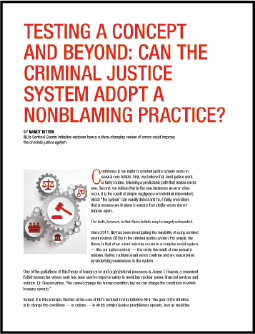
Confidence in our nation's criminal justice system rests on several core beliefs. First, we believe that most justice work is fairly routine, following a predictable path that makes errors rare. Second, we believe that in the rare instances an error does occur, it is the result of simple negligence or individual misconduct, which "the system" can readily detect and fix. Finally, we believe that processes are in place to ensure that similar errors do not happen again.
The truth, however, is that these beliefs may be largely unfounded.
Since 2011, NIJ has been investigating the feasibility of using sentinel event reviews (SERs) in the criminal justice system. Put simply, the theory is that when a bad outcome occurs in a complex social system — like our justice system — it is really the result of one person's mistake. Rather, multiple small errors combine and are exacerbated by underlying weaknesses in the system.
One of the godfathers of this theory of human error and organizational processes is James T. Reason, a renowned British researcher whose work has been used to improve safety in medicine, nuclear power, financial services and aviation. Dr. Reason writes, "We cannot change the human condition, but we can change the conditions in which humans operate."
Indeed, it is this principle that lies at the core of NIJ's Sentinel Events Initiative (SEI). The goal of the Initiative is to change the conditions — or culture — in which criminal justice practitioners operate. Just as medicine and aviation have used sentinel event reviews to instill a "culture of safety," NIJ's Initiative explores a routine, culture-changing practice that would lead to greater system reliability and, hence, greater public confidence in the integrity of our criminal justice system.
